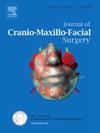Evaluation of the clinical utility of lateral cephalometry reconstructed from computed tomography extracted by artificial intelligence
IF 2.1
2区 医学
Q2 DENTISTRY, ORAL SURGERY & MEDICINE
引用次数: 0
Abstract
This study assessed the accuracy and reliability of artificial intelligence (AI)-reconstructed images of two-dimensional (2D) lateral cephalometric analyses of facial computed tomography (CT) images, which is widely used for the diagnosis of craniofacial deformities and in the planning of their treatment. Facial CT datasets from 40 patients were collected. Original 1 mm slices were reformatted to 3 mm, and then an AI algorithm reconstructed the 3 mm slices and converted them back to 1 mm to generate lateral cephalometric images. Three observers traced the craniofacial landmarks manually and with autotracing. Landmark discrepancies were quantified between the original 1 mm CT slice and the AI-reformatted 1 mm CT slice, as well as between the original 1 mm CT slice and the 3 mm CT slice. Landmark discrepancies were then compared and reliability tests conducted. AI-reconstructed 1 mm CT images showed significantly fewer discrepancies than the 3 mm CT images, particularly in critical landmarks such as the sella, basion, nasion, orbitale, and pogonion (p < 0.05). The greatest discrepancies in the 3 mm images were observed in the sella and basion. Interobserver and intraobserver reliability analyses showed high consistency (Cronbach's α > 0.7 in nearly all cases). These results support the use of AI-reconstructed images for more accurate diagnosis and treatment planning in craniofacial surgery, potentially reducing the need for additional imaging.
人工智能提取的计算机断层重建侧位头测量术的临床应用评价。
本研究评估了人工智能(AI)重建的面部计算机断层扫描(CT)图像的二维(2D)侧位测量分析的准确性和可靠性,该图像广泛用于颅面畸形的诊断和治疗计划。收集40例患者的面部CT数据集。将原始的1mm切片重新格式化为3mm,然后通过AI算法重建3mm切片并将其转换回1mm,生成侧位头视图像。三名观察员用手动和自动描摹描画了颅面标志。将原始1mm CT切片与人工智能重新格式化的1mm CT切片之间,以及原始1mm CT切片与3mm CT切片之间的地标性差异进行量化。然后比较具有里程碑意义的差异并进行信度测试。ai重建的1mm CT图像显示的差异明显小于3mm CT图像,特别是在关键地标,如鞍区、基底区、眶区、眶区和眶区(几乎所有病例的p值均为0.7)。这些结果支持在颅面手术中使用人工智能重建图像进行更准确的诊断和治疗计划,潜在地减少了对额外成像的需求。
本文章由计算机程序翻译,如有差异,请以英文原文为准。
求助全文
约1分钟内获得全文
求助全文
来源期刊
CiteScore
5.20
自引率
22.60%
发文量
117
审稿时长
70 days
期刊介绍:
The Journal of Cranio-Maxillofacial Surgery publishes articles covering all aspects of surgery of the head, face and jaw. Specific topics covered recently have included:
• Distraction osteogenesis
• Synthetic bone substitutes
• Fibroblast growth factors
• Fetal wound healing
• Skull base surgery
• Computer-assisted surgery
• Vascularized bone grafts

 求助内容:
求助内容: 应助结果提醒方式:
应助结果提醒方式:


